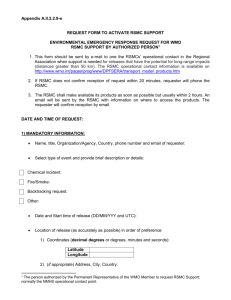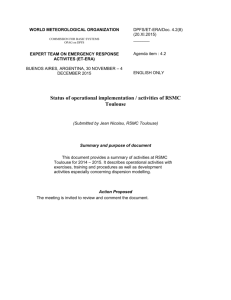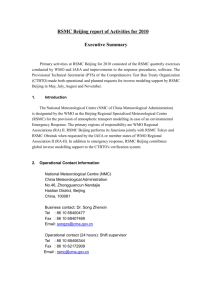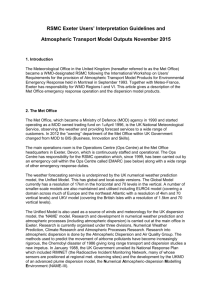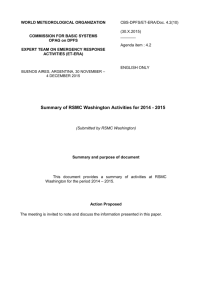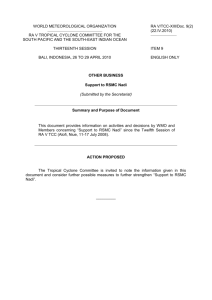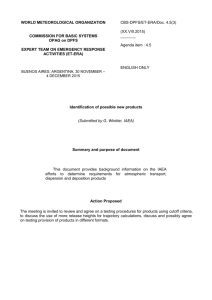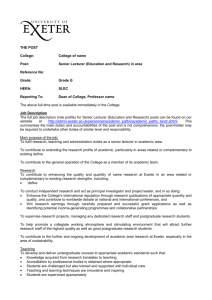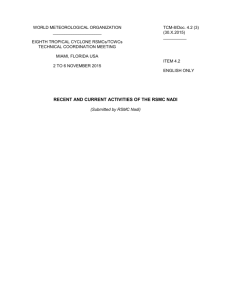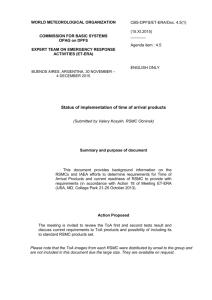RSMC Montréal report of activities for 2007
advertisement
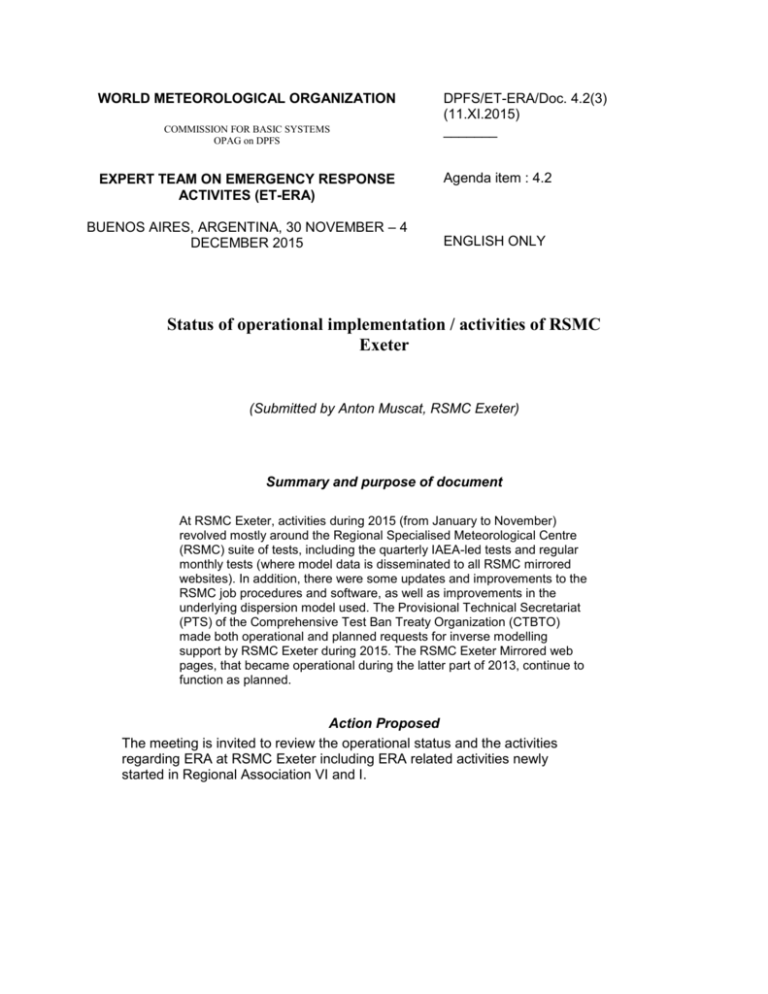
WORLD METEOROLOGICAL ORGANIZATION COMMISSION FOR BASIC SYSTEMS OPAG on DPFS EXPERT TEAM ON EMERGENCY RESPONSE ACTIVITES (ET-ERA) BUENOS AIRES, ARGENTINA, 30 NOVEMBER – 4 DECEMBER 2015 DPFS/ET-ERA/Doc. 4.2(3) (11.XI.2015) _______ Agenda item : 4.2 ENGLISH ONLY Status of operational implementation / activities of RSMC Exeter (Submitted by Anton Muscat, RSMC Exeter) Summary and purpose of document At RSMC Exeter, activities during 2015 (from January to November) revolved mostly around the Regional Specialised Meteorological Centre (RSMC) suite of tests, including the quarterly IAEA-led tests and regular monthly tests (where model data is disseminated to all RSMC mirrored websites). In addition, there were some updates and improvements to the RSMC job procedures and software, as well as improvements in the underlying dispersion model used. The Provisional Technical Secretariat (PTS) of the Comprehensive Test Ban Treaty Organization (CTBTO) made both operational and planned requests for inverse modelling support by RSMC Exeter during 2015. The RSMC Exeter Mirrored web pages, that became operational during the latter part of 2013, continue to function as planned. Action Proposed The meeting is invited to review the operational status and the activities regarding ERA at RSMC Exeter including ERA related activities newly started in Regional Association VI and I. RSMC Exeter report of activities for 2015 1. Introduction The UK Met Office is designated by the WMO as the Regional Specialized Meteorological Centre (RSMC) for the provision of atmospheric transport modelling in case of an environmental Emergency Response. The regions of responsibility are WMO Regional Associations (RA) I & VI, which encompasses Europe, Ukraine, the Russian Federation and Africa. In the case of an event, e.g. an accident at a Nuclear Power Plant (NPP) RSMC Exeter would respond jointly with RSMC Toulouse. In addition to emergency response, RSMC Exeter contributes global inverse modelling support to the CTBTO verification system 2. Operational Contact Information RSMC Exeter, Ops Centre, The Met Office, Fitzroy Road, Exeter, Devon. EX1 3PB. United Kingdom Business contact: Mr Anton Muscat Tel : +44 1392 886033 Fax : +44 1392 884549 Email : anton.muscat@metoffice.gov.uk Operational contact (24 hours): EMARC (Environmental Monitoring and Response Centre Tel : +44 1392 886095 Fax : +44 1392 884549 Email : emarc@metoffice.gov.uk 3. Responses and information on dissemination of products i. Participation in international inverse dispersion modeling events and exercises with CTBTO During 2015 RSMC Exeter received occasional requests for both real and exercise scenarios from the Provisional Technical Secretariat of the Comprehensive Test Ban Treaty Organisation (CTBTO). These were all responded to within the expected timescale. 4. I) Routine operations RSMC Exeter took part in a planned International Atomic Energy Authority (IAEA) quarterly exercise as lead RSMC (in conjunction with RSMC Toulouse) in August 2015. Graphics were posted to the relevant RSMC mirrored websites, as well as to the IAEA and to NMSs within RA I and RA VI In addition, RSMC Exeter continues to respond to the monthly tests (initiated by RSMCs Melbourne, Montreal and Washington) by running dispersion models and sending output to the mirrored RSMC web pages. This has proved to be an extremely useful test of the system, helping Exeter (and other RSMCs) to identify problems at any early stage and to quickly rectify any issues. Further, during the summer and Autumn of 2015 RSMC Exeter has contributed towards two test exercises for the newly-proposed Time of Arrival (ToA) products. 5. Lessons learned from recent experiences and significant operational and technical changes: i. All requests for RSMC support during 2015 were carried out in a timely fashion. ii. Various incremental changes continue to be made to NAME III to improve the capability of this model. Anton Muscat (RSMC Exeter) attended the International Conference on Global Preparedness and Response at the IAEA in Vienna, 19-23 October 2015 as part of a wider WMO contingent that included Dr. Xu Tang (Director of the Weather and Disaster Risk Reduction Services Department within WMO) Mr. Ata Hussain (Secretariat) and Mr. Gerhard Wotawa (RSMC Vienna). The purpose of this conference was to bring subject matter experts together from across the Emergency Response community in relation to a NPP (or similar) accident. Dr.Tang gave a presentation and speech highlighting the close working relationship between IAEA and WMO, stretching back over 25 years. In addition, a poster was presented to the Conference describing the function of the RSMCs. Further, a summary address was made to the Conference highlighting the importance of both RSMCs and National Meteorological and Hydrological Services (NMHSs) to the Emergency Response community in the event of a NPP (or similar) accident. In November 2014 a nuclear accident exercise took place at Eurocontrol in Brussels. The purpose of this exercise was to help aviation users understand what issues they might face in the event of an accident from a NPP. A fuller description of this exercise is available in last year’s (2014) report for RSMC Exeter. As a result of that exercise, the aviation community in Europe have begun the process of trying to ascertain what specific, bespoke, products they would like to receive from the RSMCs in the event of a NPP accident. In addition to this, during 2015 the Civil Aviation Authority (CAA) and National Air Traffic Service (NATS) in the UK have both made representations to RSMC Exeter about what information (specifically plume modelling information) they would be able to attain from RSMC Exeter or the Met Office if a NPP accident occurred. It is clear that the aviation industry has a clear need for such information and that, currently, the RSMC community is not able to provide this information since there is no mandate to do so, nor is there a clearly defined requirement. It seems highly likely that this will become a major requirement of RSMCs in the future. 6. Operational issues and challenges: There is a continued need to ensure that all operational staff are regularly exercised and tested in their execution of all aspects of Emergency Response. The initiation of the dispersion model (NAME) runs is a straightforward task, since the process is well-documented and performed frequently by the team. However, the writing of the Joint Statement is somewhat more involved and it is this aspect that has been focussed on. To ensure that all team members are up to date, specific “training” days continue to be rostered to allow the EMARC (RSMC) forecasters dedicated time away from operational duties in which to continually practice these (and other) Emergency Response activities. 7. Summary and status of operational atmospheric transport and dispersion models The Met Office’s Numerical Atmospheric-dispersion Modelling Environment, NAME III (v. 6.3 is the current version) is a Lagrangian particle-trajectory model designed to predict the atmospheric dispersion and deposition of gases and particulates. A large number of particles are used to represent releases from pollution sources. Each model particle can have its own characteristics, represent different compounds or chemicals and represent real particulate sizes. These particles are advected by the temporally varying, three-dimensional model winds and dispersed using random walk techniques that take into account the atmospheric turbulent velocity structures. Several deposition processes remove particles from the atmosphere; i) impaction with the surface, ii) washout where particles are `swept out' by falling precipitation, iii) rainout where particles are absorbed directly into cloud droplets as they form and, iv) fall out due to gravity. A modular code design offers the user flexibility in configuring model runs and provides an infrastructure onto which extra modules could be added. NAME is capable of utilising meteorological data from a variety of sources: fields from a numerical weather prediction model, radar rainfall estimates, and single-site observations, with the available data used in a nested sense. Other effects, such as plume-rise (for buoyant or momentum-driven releases), radioactive decay of radio nuclides, and chemical transformations, can also be included. At short ranges, NAME functionality includes modelling of short-period concentration fluctuations and the effects of small-scale terrain or isolated buildings on dispersion. During 2015, the introduction of new computers have allowed RSMC Exeter to increase the number of computer processors and the number of particles used by each RSMC run, resulting in smoother output with no increase in run time. In addition, the resolution of our global meteorology (used by NAME for RSMC runs) has increased from ~25km to ~17km and the global meteorological model has a new dynamical core called ENDGame. If there is a requirement then a fuller document describing the changes introduced by ENDGame can be supplied to interested parties, although this particular RSMC Report of Activities is not really a suitable vehicle for conveying the information. 8. Plans for 2016: In 2016 we plan to move to NAME version 6.5 (the intention had been to move to this version during 2015 but plans needed to be delayed). Features new in 6.5 which are relevant to Emergency Response are: Improved advection close to the poles Improved representation of mesoscale motions in the atmosphere (the size between the motions resolved by the meteorological models and eddies) Improved representation of gaseous and particulate Iodine Ability to use UKPP and EuroPP rainfall There is also an improved convection scheme which we may turn on for RSMC runs depending on whether this impacts the run time or not. In addition, and aside from the model changes described above, the intention in 2016 is to upgrade the graphics on all runs on EMARC-NAME, including RSMC runs. This will result in colour-plots becoming available for RSMC runs, as well as ensuring that the underlying mapping on the RSMC products shows greater detail.
